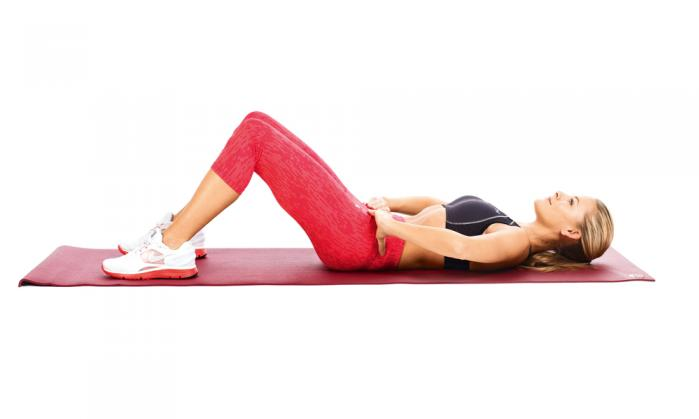Your pelvic floor muscles are your deepest pelvic stabilizing muscles. They are also the base of support for your entire core and therefore require a lot of strength for optimum health. Oftentimes women aren’t aware how to engage these muscles until they are taught when they’re pregnant and many men will never know. The support these muscles provide can do tremendous things for core strength, back health and making sure you don’t wet yourself when you laugh or cough. Now that’s important!
Here’s how to determine your own pelvic floor health and how to build strength of those muscles.
1. Lie on you back with your knees bent and feet flat on the floor.
2. Determine your neutral pelvis by rocking it back and forth and trying to stop in the middle place of ease. Your low back will be off the floor and the two bony points at the front of your pelvis (“hip bones”) should be in the same vertical plane as your pubic bone – imagine placing a dinner plate atop the front of your pelvis, it should lay completely flat. You also should ideally be able to completely release your hip flexors.
3. Lay your arms by your side and close your eyes. Deeply and internally (your pelvis will not move) focus on the following:
– drawing your pelvic bone to your tailbone
– drawing your sitz bones narrower or towards each other
– lifting up your perineum which is like a balloon lifting up towards your diaphragm
4. Hold this for a few counts and then completely release.
You also can think of this like an elevator, engaging (1) to lift to first floor, next layer (2) takes you to second floor, third layer (3) all the way up to fifth. The ability to engage and then completely release determines your pelvic floor health. You can think of your first effort as a snapshot of your pelvic floor health and determine for yourself if you need more strengthening because it was difficult to engage or if you need more release because that was the difficult part. You want to be able to achieve both equally.
To greater determine your strength, find the engagement of the muscles again and then try to hover your right foot an inch off the floor. Hold for a few counts, set foot down and completely release your pelvic floor. Reengage and try again with the left foot, completely release. Engage again and try to hover both feet off of the floor. This will probably be very challenging but eventually you want to have the deep pelvic floor muscles so strong that when you engage them in neutral spine you can add the weight of the legs and no movement will happen in the pelvis.
Wishing you deep engagement.
Love,
— Jill


